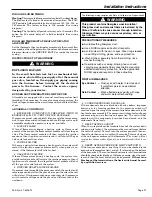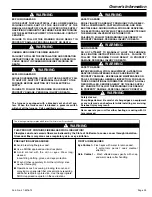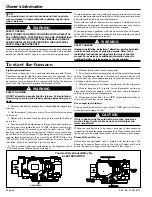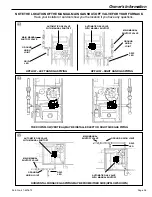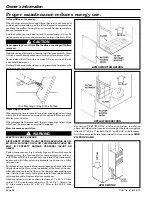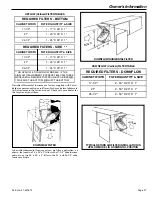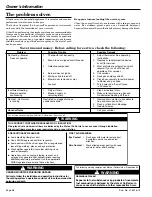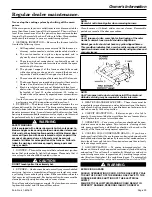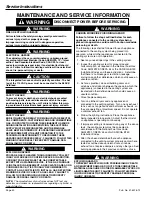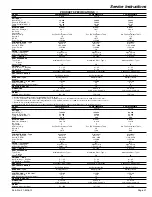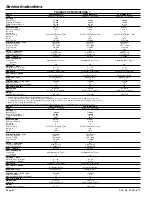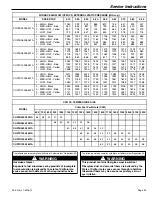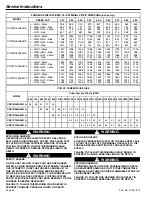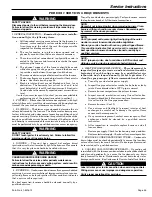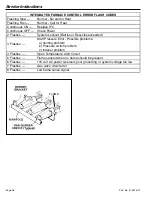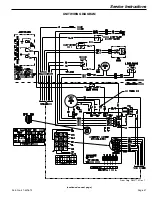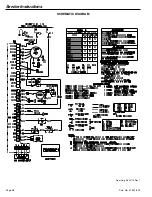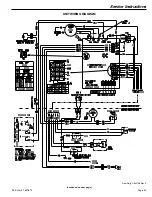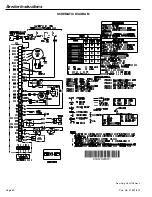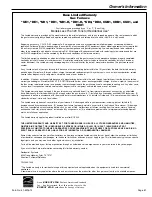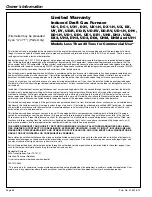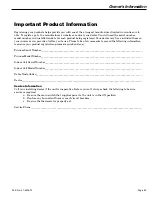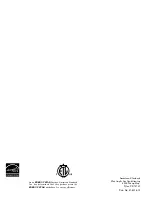
Service Instructions
Page 45
Pub. No. 41-5016-12
PERIODIC SERVICING REQUIREMENTS
▲
WARNING
!
SAFETY HAZARD
Disconnect power to the unit before removing the blower door.
Failure to follow this warning could result in personal injury
from moving parts.
1. GENERAL INSPECTION —
Examine the furnace installa-
tion annually for the following items:
a. All flue product carrying areas external to the furnace (i.e.
chimney, vent connector) are clear and free of obstruction.
A vent screen in the end of the vent (flue) pipe must be
inspected for blockage annually.
b. The vent connector is in place, slopes upward and is
physically sound without holes or excessive corrosion.
c. The return air duct connection(s) is physically sound, is
sealed to the furnace and terminates outside the space
containing the furnace.
d. The physical support of the furnace should be sound
without sagging, cracks, gaps, etc., around the base so as
to provide a seal between the support and the base.
e. There are no obvious signs of deterioration of the furnace.
f. The burner flames are in good adjustment without erratic
flames. See illustation on page 46.
g. Fresh air inlet and vent are not blocked and free from
obstruction. The horizontal or verti cal vent and inlet
must be located at least 12 inches minimum (18 inches in
Canada) above the normally expected snow accumulation
level.
Contact your service agent if you feel you are uncomfortable
performing any of the inspections noted in section 1.
2. FILTERS — Filters should be cleaned or replaced (with high
velocity filters only), monthly and more frequently during high use
times of the year such as midsummer or midwinter.
3. BLOWERS — The blower size and speed determine the air
volume delivered by the furnace. The blower motor bearings are
factory lubricated and under normal operating conditions do not
require servicing. If motor lubrication is required it should only be
done by a qualified servicer. Annual cleaning of the blower wheel
and housing is recommended for maximum air output, and this
must be performed only by a qualified servicer or service agency.
▲
WARNING
!
SAFETY HAZARD
DO NOT touch igniter. It is extremely hot. Failure to follow this
warning could result in severe burns.
4. IGNITER — This unit has a special hot surface direct
ignition device that automatically lights the burners. Please note
that it is very fragile and should be handled with care.
▲
WARNING
!
CARBON MONOXIDE POISONING HAZARD
Failure to follow the service and/or periodic maintenance
instructions for the furnace and venting system, could result in
carbon monoxide poisoning or death.
5. BURNERS — Gas burners do not normally require scheduled
servicing, however, accumulation of foreign material may cause a
yellowing flame or delayed ignition. Either condition indicates
that a service call is required.
For best operation, burners should be cleaned annually by a
qualified servicer.
Turn off gas and electric power supply. To clean burners, remove
the top burner bracket. Lift burners from orifices.
NOTE:
Be careful not to break igniter when removing burners. Clean
burners with brush and/or vacuum cleaner. Reassemble parts
by reversal of the above procedure.
NOTE:
On LP (propane) units, some light yellow tipping of the outer
mantle is normal. Inner mantle should be bright blue.
Natural gas units should not have any yellow tipped flames.
This condition indicates that a service call is required. For
best operation, burners should be cleaned annually by a
qualified servicer.
NOTE:
On LP (propane) units, due to variations in BTU content and
altitude, servicing may be required at shorter intervals.
6. HEAT EXCHANGER/FLUE PIPE —
These items must be
inspected for signs of corrosion, and/or deterioration at the
beginning of each heating season by a qualified service
technician and cleaned annually for best operation. To
clean flue gas passages, follow recommendations below:
a. Turn off gas and electric power supply.
b. Inspect flue pipe exterior for cracks, leaks, holes or leaky
joints. Some discoloration of PVC pipe is normal.
c. Remove burner compartment door from furnace.
d. Inspect around insulation covering flue collector box.
Inspect induced draft blower connections from recupera-
tive cell and to the flue pipe connection.
e. Remove burners. (See 39.)
f. Use a mirror and flashlight to inspect interior of heat
exchanger, be careful not to damage the igniter, flame
sensor or other components.
g. If any corrosion is present, contact a service agency. Heat
exchanger should be cleaned by a qualified service
technician.
h. After inspection is complete replace burners, and all
furnace doors.
i. Restore gas supply. Check for leaks using a soap solution.
Restore electrical supply. Check unit for normal operation.
7. FURNACE CONDENSATE DRAIN TUBES — Condensate
drain tubes must be checked periodically to assure that conden-
sate can flow freely from unit to drain. If a drain problem cannot
be corrected, call a qualified servicer.
8. COOLING COIL CONDENSATE DRAIN — If a cooling coil
is installed with the furnace, condensate drains should be checked
and cleaned periodically to assure that condensate can drain
freely from coil to drain. If condensate cannot drain freely water
damage could occur. (See Condensate Drain in Installer’s Guide).
▲
CAUTION
!
Label all wires prior to disconnection when servicing controls.
Wiring errors can cause improper and dangerous operation.
Verify proper operation after servicing.

